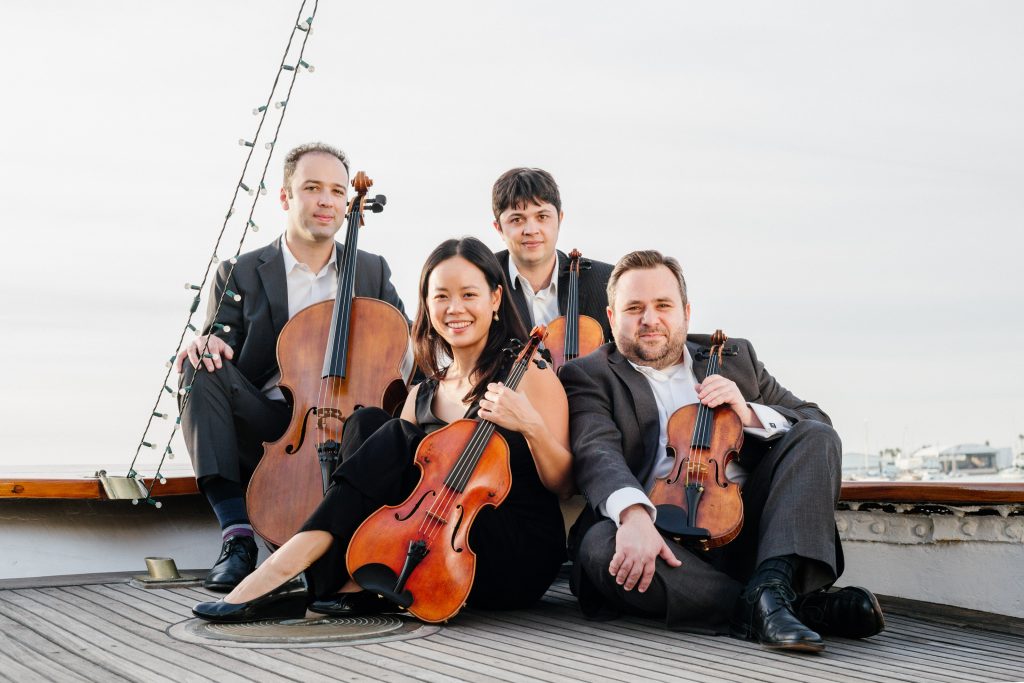The Hausmann Quartet Unleashes Humor and Profundity in Haydn
Adjacent to the ticket table at the Hausmann Quartet’s Sunday (September 17) Haydn Voyages concert stood a chalkboard marking the string quartet’s progress: 17.6% of the composer’s 68 string quartets performed thus far. That our local string quartet—Hausmann is in residence at San Diego State University—is serious about traversing Haydn’s complete string quartet repertory and wants its loyal audience to keep score could not be more charming.

Hausmann Quartet: (from left) Alex Greenbaum, Angela Choong, Isaac Allen, Bram Goldstein [photo (c) Samantha Zauscher]
First violinist Isaac Allen’s supple, driving line energized the ensemble without overpowering it, and cellist Alex Greenbaum complemented Allen’s approach with welcome hints of humor. Violist Angela Choong contributed sonic warmth in the mid-range, as well as deft, persuasive phrasing, Although second violinist Bram Goldstein proved to be a reliable team player, he could strengthen the quartet’s profile with a less deferential stance.
Hausmann’s Haydn Voyages are performed on the upper deck of the Berkeley, the Maritime Museum of San Diego’s historic ferryboat moored at the edge of San Diego Bay. In the opening movement of Haydn’s F Major Quartet, an adjacent cruise ship left its berth with a few mighty blasts of its horn, adding a color and countersubject to the Haydn that John Cage would have relished. The Hausmann performers simply smiled and kept playing with relish.
For stylistic contrast, Hausmann chose early 20th-century works by Igor Stravinsky and George Antheil as well as a recent piece by the contemporary Serbian-Canadian composer Ana Sokolović. Sporting astringent progressions and gossamer counterpoint, Sokolović’s short, three movement “Commedia dell’arte” displayed surprising similarities to Stravinsky’s 1914 Three Pieces for String Quartet, even though they were produced nearly a century apart. Perhaps the half-life of musical neoclassicism is longer than most musicologists have allowed in their snappy chronologies of western music since “The Rite of Spring.”
Given George Antheil’s reputation for writing boisterous avant-garde works that provoked riotous reactions from his audiences—the composer proudly titled his 1945 autobiography The Bad Boy of Music—I found his 1919 “Lithuanian Night” surprisingly tame, although he did end the piece with an aggressive, dissonant chord.
To their credit, Hausmann approached these modern pieces with the same animated transparency that graced their Haydn quartets.
The ensemble opened their program with Haydn’s buoyant E-flat Major Quartet, Op. 33, No. 2, a less probing offering that the F Major, Op. 74, No. 2, but a playful work that stresssed the composer’s good humor and ability to tease a musically sophisticated listener.
This installment of the Haydn Voyages concerts by the Hausmann Quartet was underwritten by pH PROJECTS and given at the Maritime Museum of San Diego on Sunday, September 17. The next Haydn Voyage is scheduled for November 12 at the same venue.

Ken Herman, a classically trained pianist and organist, has covered music for the San Diego Union, the Los Angeles Times’ San Diego Edition, and for sandiego.com. He has won numerous awards, including first place for Live Performance and Opera Reviews in the 2017, the 2018, and the 2019 Excellence in Journalism Awards competition held by the San Diego Press Club. A Chicago native, he came to San Diego to pursue a graduate degree and stayed.Read more…
